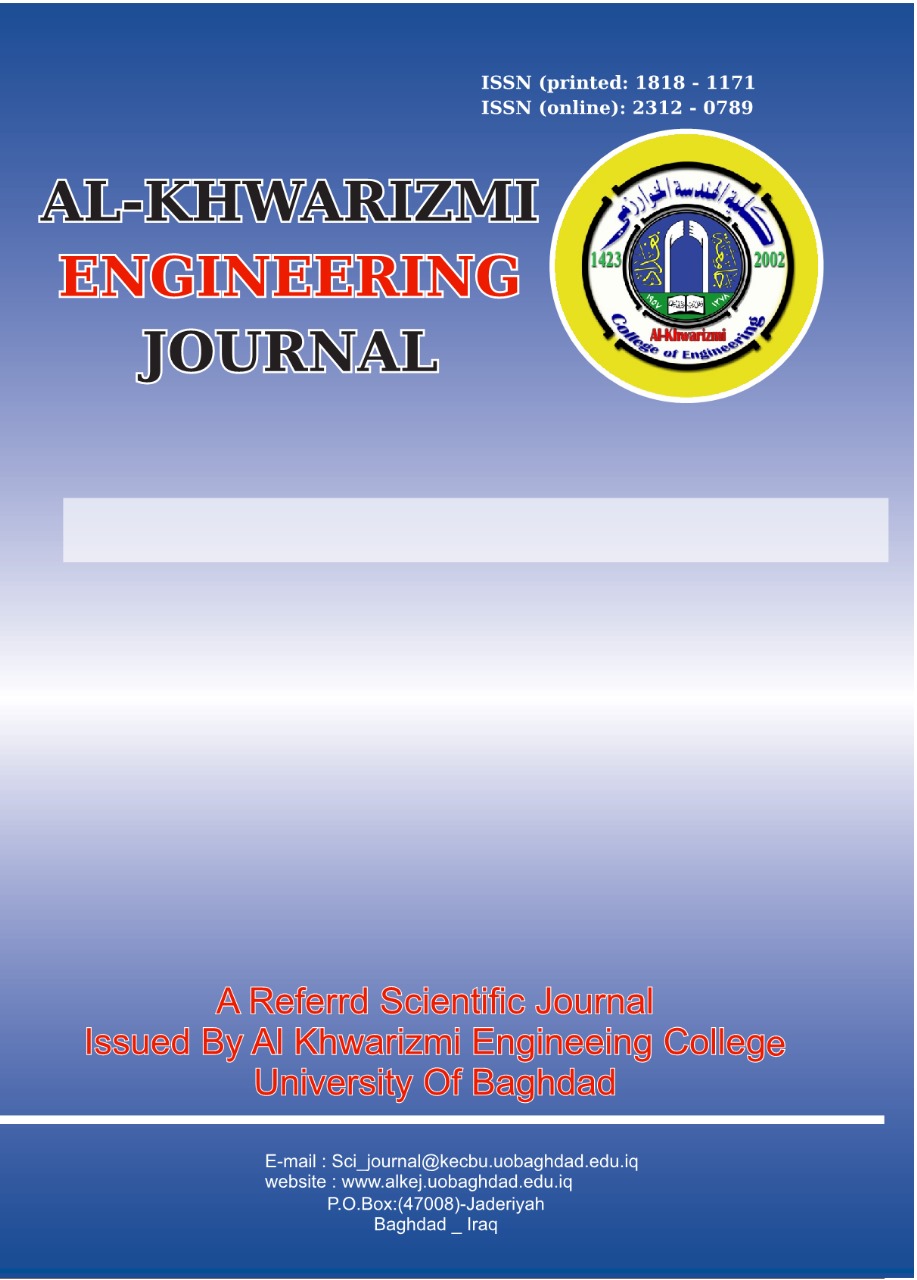Removal of Ciprofloxacin Antibiotic from Synthesized Aqueous Solution Using Three Different Metals Nanoparticles Synthesized Through the Green Method
DOI:
https://doi.org/10.22153/kej.2023.02.002الملخص
This study investigates the possibility of removing ciprofloxacin (CIP) using three types of adsorbent based on green-prepared iron nanoparticles (Fe.NPs), copper nanoparticles (Cu. NPS), and silver nanoparticles (Ag. NPS) from synthesized aqueous solution. They were characterized using different analysis methods. According to the characterization findings, each prepared NPs has the shape of a sphere and with ranges in sizes from of 85, 47, and 32 nanometers and a surface area of 2.1913, 1.6562, and 1.2387 m2/g for Fe.NPs, Cu.NPs and Ag.NPs, respectively. The effects of various parameters such as pH, initial CIP concentration, temperature, NPs dosage, and time on CIP removal were investigated through batch experiments. The results showed that 10 mg/L CIP was removed by 100%, 92% and 79% within 180 min using Fe.NPs, Cu.NPs, and Ag.NPs respectively. In addition to this, kinetic models of the adsorption and mechanism of CIP removal were studied. The cinematic analysis demonstrated that adsorption is a physics adsorption mechanism with an energy of 0.846 kJ.mol-1, 1.720 kJ.mol-1, and 3.872 kJ.mol-1, while the low activation energies of 17.660 kJ.mol-1, 13.221 kJ.mol-1, and 14.060 kJ.mol-1 for Fe.NPs, Cu.NPs, and Ag.NPs respectively. The kinetic removal process follows a pseudo-first-order model following a physical diffusion-controlled reaction. The data on adsorption was analyzed using the Langmuir, Freundlich, Temkin, and Dubinin models, as well as thermodynamic factors, indicating that the process is appropriate and endothermic sorption. The most practical adsorbent was Fe.NPs
التنزيلات
المراجع
C. A. Igwegbe, S. N. Oba, C. O. Aniagor, A. G. Adeniyi, and J. O. Ighalo, “Adsorption of ciprofloxacin from water: A comprehensive review,” J. Ind. Eng. Chem., vol. 93, pp. 57–77, 2021, doi: 10.1016/j.jiec.2020.09.023.
N. Genç and E. C. Dogan, “Adsorption kinetics of the antibiotic ciprofloxacin on bentonite, activated carbon, zeolite, and pumice,” Desalin. Water Treat., vol. 53, no. 3, pp. 785–793, 2015, doi: 10.1080/19443994.2013.842504.
M. A. Asghar et al., “Iron, copper and silver nanoparticles: Green synthesis using green and black tea leaves extracts and evaluation of antibacterial, antifungal and aflatoxin B1 adsorption activity,” LWT - Food Sci. Technol., vol. 90, no. January, pp. 98–107, 2018, doi: 10.1016/j.lwt.2017.12.009.
X. Weng, L. Huang, Z. Chen, M. Megharaj, and R. Naidu, “Synthesis of iron-based nanoparticles by green tea extract and their degradation of malachite,” Ind. Crops Prod., vol. 51, pp. 342–347, 2013, doi: 10.1016/j.indcrop.2013.09.024.
N. Sharma and N. Dhiman, “Kinetic and Thermodynamic Studies for Ciprofloxacin Hydrochloride Adsorption from Aqueous Solution on CuO Nanoparticles,” vol. 10, no. 5, pp. 98–106, 2017.
M. Batool, “Degradation of Malachite Green by Green Synthesized Copper Nanoparticles
by Using Aloe Barbadensis Leaf Extracts,” Arch. Nanomedicine Open Access J., vol. 1, no. 2, pp. 29–34, 2018, doi: 10.32474/anoaj.2018.01.000108.
C. Raju, S. Nooruddin, and K. S. Babu, “Studies on leaf extract mediated synthesis of copper nanoparticles for the removal of bromo cresol green dye from synthetic waste waters,” Ijsetr, vol. 6, no. 10, pp. 1404–1411, 2017.
M. Batool, M. Z. Qureshi, F. Hashmi, N. Mehboob, and W. M. Daoush, “Adsorption of Congo red (acid red 28) azodye on biosynthesized copper oxide nanoparticles,” Asian J. Chem., vol. 31, no. 3, pp. 707–713, 2019, doi: 10.14233/ajchem.2019.21752.
[M. Leili, M. Fazlzadeh, and A. Bhatnagar, “Green synthesis of nano-zero-valent iron from Nettle and Thyme leaf extracts and their application for the removal of cephalexin antibiotic from aqueous solutions,” Environ. Technol. (United Kingdom), vol. 39, no. 9, pp. 1158–1172, 2018, doi: 10.1080/09593330.2017.1323956.
I. Ali, Z. A. AL-Othman, and A. Alwarthan, “Green synthesis of functionalized iron nano particles and molecular liquid phase adsorption of ametryn from water,” J. Mol. Liq., vol. 221, pp. 1168–1174, 2016, doi: 10.1016/j.molliq.2016.06.089.
H. R. Pouretedal and N. Sadegh, “Effective removal of Amoxicillin, Cephalexin, Tetracycline and Penicillin G from aqueous solutions using activated carbon nanoparticles prepared from vine wood,” J. Water Process Eng., vol. 1, pp. 64–73, 2014, doi: 10.1016/j.jwpe.2014.03.006.
Shi, Z.-Q.; Liu, Y.-S.; Xiong, Q.; Cai, W.-W.; and Ying, G.-G. (2019). Occurrence, toxicity and transformation of six typical benzotriazoles in the environment: A review. Science of the Total Environment, 661, 407-421.
Pouretedal. H.R.; and Sadegh, N. (2014). Effective removal of Amoxicillin, Cephalexin, Tetracycline and Penicillin G from aqueous solutions using activated carbon nanoparticles prepared from vine wood. Journal of Water Process Engineering, 1, 64-73.
Balcioglu. I.A.; and Otker, M. (2004). Pre-treatment of antibiotic formulation wastewater by O3, O3/H2O2, and O3/UV processes. Turkish Journal of Engineering and Environmental Sciences, 28(5), 325-32.
Davis, T.A.; Volesky, B.; and Mucci, A. (2003). A review of the biochemistry of heavy metal biosorption by brown algae. Water Research, 37(18), 4311-4330.
Xian, Q.; Hu, L.; Chen, H.; Chang, Z.; and Zou, H. (2010). Removal of nutrients and veterinary antibiotics from swine wastewater by a constructed macrophyte floating bed system. Journal of Environmental Management, 91(12), 2657-2661.
Ahalya, N.; Ramachandra, T.V.; and Kanamadi, R.D. (2003). Biosorption of heavy metals. Research Journal of Chemistry and Environment, 7(4), 71-78.
Zou, C.; Jiang, W.; Liang, J.; Sun, X.; and Guan, Y. (2019). Removal of Pb(II) from aqueous solutions by adsorption on magnetic bentonite. Environmental Science and Pollution Research, 26(2), 1315-1322.
Ghorai. S.; Sarkar. A.; and Pal. S. (2014). Rapid adsorptive removal of toxic Pb2+ ion from aqueous solution using recyclable, biodegradable nanocomposite derived from templated partially hydrolyzed xanthan gum and nanosilica. Bioresource Technology, 170, 578-582.
De Gisi, S.; Lofrano, G.; Grassi, M.; M, Notarnicola. (2016) Characteristics and adsorption capacities of low-cost sorbents for wastewater treatment: A review. Sustainable Materials and Technologies, 9, 10-40.
Wang, J.; Zhang, T.; Li. M.; Yang. Y.; Lu. P.; Ning. P.; and Wang, Q. (2018). Arsenic removal from water/wastewater using layered double hydroxide derived adsorbents, a critical review, RSC Advances. Royal Society of Chemistry, 8(40), 22694-22709.
Cheng, M.; Zhang. X .; Shi. Y.; Shi, D.; Zhu, G.; and Fan, J. (2019). Highly efficient removal of ceftiofur sodium using a superior hydroxyl group functionalized ionic liquid-modified polymer. Science of the Total Environment, 662, 324-331.
Loo, Y.Y.; Chieng, B.W.; Nishibuchi, M.; and Radu, S. (2012). Synthesis of silver nanoparticles by using tea leaf extract from Camellia Sinensis. International Journal of Nanomedicine, 7, 4263-4267.
Kamar, F.H.; Nechifor, A.C.; Nechifor, G.; AL-Musawi, T.J.; and Mohammed. A.H. (2017). Aqueous phase biosorption of Pb(II), Cu(II), and Cd(II) onto cabbage leaves powder. International Journal of Chemical Reactor Engineering, 15(2), Article number: 20150178.
Hossain. M.; Ngo, H.; Guo, W.S.; and Setiadi, T. (2012). Adsorption and desorption of copper(II) ions onto garden grass, Bioresource Technology, 121, 386-395.
Holan, Z.R.; and Volesky, B. (1995). Accumulation of cadmium, lead, and nickel by fungal and wood biosorbents, Applied Biochemistry and Biotechnology, 53(2), 133-146.
Khodadadi,.M.; Al-Musawi, T.; Kamranifar, M.; Saghi, M.; and Panahi, A. (2019). A comparative study of using barberry stem powder and ash as adsorbents for adsorption of humic acid, Environmental Science and Pollution Research. Environmental Science and Pollution Research, 26(25), 26159-26169.
Dhiman, N.; and Sharma, N. (2018). Batch adsorption studies on the removal of ciprofloxacin hydrochloride from aqueous solution using ZnO nanoparticles and groundnut (Arachis hypogaea) shell powder: a comparison*, Indian Chemical Engineer. Taylor & Francis, 61(1), 67-76.
Mohammed A.A.; Brouers, F.; Samaka I.S.; and Al-Musawi T.J. (2018). Role of Fe3O4 magnetite nanoparticles used to coat bentonite in zinc(II) ions sequestration, Environmental Nanotechnology, Monitoring & Management, 10, 17-27.
Saif, S.; Tahir, A.; and Chen, Y. (2016). Green synthesis of iron nanoparticles and their environmental applications and implications. Nanomaterials, 6(11), 1-26.
Ali, I.; Al-Othman, Z.A.; and Alwarthan, A. (2016). Synthesis of composite iron nano adsorbent and removal of ibuprofen drug residue from water. Journal of Molecular Liquids, 219, 858-864.
Hassan, A.K.; Rahman, M.M.; Chattopadhay, G.; and Naidu, R. (2019). Kinetic of the degradation of sulfanilic acid azochromotrop (SPADNS) by Fenton process coupled with ultrasonic irradiation or L-cysteine acceleration. Environmental Technology & Innovation, 15, 100380.
Ali, I.; AL-Othman, Z. A.; and Alwarthan, A. (2016). Green synthesis of functionalized iron nano particles and molecular liquid phase adsorption of ametryn from water. Journal of Molecular Liquids, 221, 1168-1174.
Wang. J.; Ma, H.; Yuan, W.; He, W.; Wang, S.; and You, J. (2014). Synthesis and characterization of an inorganic/organic-modified bentonite and its application in methyl orange water treatment. Desalination and Water Treatment, 52(40-42), 7660-7672.
Qassim, A.W. (2015). Spectrophotometric determination of ciprofloxacin hydrochloride in pharmaceutical formulation ciproxin. International Journal of Advanced Scientific and Technical Research, 3(5), 135-146.
[36] Sharma, N.; and Dhiman, N. (2017). Kinetic and thermodynamic studies for ciprofloxacin hydrochloride adsorption from Aqueous solution on CuO nanoparticles, 10(5), 98-106.
[37] Demirezen, D.A.; Yıldız, Y.Ş.; and Yılmaz, D.D. (2019). Amoxicillin degradation using green synthesized iron oxide nanoparticles: Kinetics and mechanism analysis. Environmental Nanotechnology, Monitoring & Management, 11, 100219.
Kumar, R.; Singh, N.; and Pandey, S.N. (2015). Potential of green synthesized zero-valent iron nanoparticles for remediation of lead-contaminated water. International Journal of Environmental Science and Technology. Springer Berlin Heidelberg, 12(12), 3943-3950.
Asghar, M.A.; Zahir, E.; Shahid, S.M.; Khan, M.N.; Asghar, M.A., Iqbal, J.; and Walker, G. (2018). Iron, copper and silver nanoparticles: Green synthesis using green and black tea leaves extracts and evaluation of antibacterial, antifungal and aflatoxin B1 adsorption activity. LWT, 90, 98-107.
Shahwan, T.; Sirriah, S.A.; Nairat, M.; Boyacı, E.; Eroğlu, A.E.; Scott, T.B.; and Hallam, K.R. (2011). Green synthesis of iron nanoparticles and their application as a Fenton-like catalyst for the degradation of aqueous cationic and anionic dyes. Chemical Engineering Journal, 172(1), 258-266.
Khoshnamvand, N.; Ahmadi, S.; and Mostafapour, F. K. (2017). Kinetic and isotherm studies on ciprofloxacin an adsorption using magnesium oxide nanopartices. Journal of Applied Pharmaceutical Science, 7(11), 79-83.
Wang, H.; Chen, L.; Weng, L.L.; Zhang, M.Y.; and Shen, Q. (2014). Surface properties and dissolution kinetics of tea polyphenols. Journal of Adhesion Science and Technology, 28(24), 2416-2423.
Abdel-Aziz, H.M.; Farag, R.S.; and Abdel-Gawad, S.A. (2019). Carbamazepine removal from aqueous solution by green synthesis zero-valent iron/cu nanoparticles with ficus benjamina leaves extract. International Journal of Environmental Research, 13(5), 843-852.
KSV, G.; Reddy, P.H.; Zamare, D. (2017). Green synthesis of iron nanoparticles using green tea leaves extract. Journal of Nanomedicine & Biotherapeutic Discovery, 7(1), 1-4.
Elahimehr, Z.; Nemati, F.; and Elhampour, A. (2020). Synthesis of a magnetic-based yolk-shell nano-reactor: A new class of monofunctional catalyst by Cu0-nanoparticles and its application as a highly effective and green catalyst for A3 coupling reaction. Arabian Journal of Chemistry, 13(1), 3372-3382.
Shih, Y.H.; Hsu, C.Y.; and Su, Y.F. (2011). Reduction of hexachlorobenzene by nanoscale zero-valent iron: Kinetics, pH effect, and degradation mechanism. Separation and Purification Technology, 76(3), 268-274.
Mohammed, A.A.; Najim, A.A.; Al-Musawi, T.J.; and Alwared, A.I. (2019). Adsorptive performance of a mixture of three nonliving algae classes for nickel remediation in synthesized wastewater. Journal of Environmental Health Science and Engineering, 17(2), 529-538.
Ye, S.; Lv, X.; and Zhou, A. (2009). In vitro evaluation of the efficacy of sodium humate as an aflatoxin b1 adsorbent. Australian Journal of Basic and Applied Sciences, 3(2), 1296-1300.
Wu, Q.; Li, Z.; Hong, H.; Yin, K.; and Tie, L. (2010). Adsorption and intercalation of ciprofloxacin on montmorillonite. Applied Clay Science, 50(2), 204-211.
Weng, X.; Huang, L.; Chen, Z.;Megharaj,M.; and Naidu, R. (2013). Synthesis of iron-based nanoparticles by green tea extract and their degradation of malachite. Industrial Crops and Products, 51, 342-347.
Gai, W. Z.; Deng, Z. Y.; and Shi, Y. (2015). Fluoride removal from water using high-activity aluminum hydroxide prepared by the ultrasonic method. RSC Advances, 5(102), 84223-84231.
Kowanga, K. D.; Gatebe, E.; Mauti, G. O.; and Mauti, E. M (2016). Kinetic , sorption isotherms , pseudo-first-order model and pseudo-second-order model studies of Cu ( II ) and Pb ( II ) using defatted Moringa oleifera seed powder. The journal of phytopharmacology, 5(2), 71-78.
Hassan, A.K.; Al-Kindi, G.Y.; and Ghanim, D., (2020). Green synthesis of bentonite-supported iron nanoparticles as a heterogeneous Fenton-like catalyst: Kinetics of decolorization of reactive blue 238 dye. Water Science and Engineering, 13(4), 286-298.
Leili, M.; Fazlzadeh, M.; and Bhatnagar, A. (2018). Green synthesis of nano-zero-valent iron from Nettle and Thyme leaf extracts and their application for the removal of cephalexin antibiotic from aqueous solutions. Environmental Technology, 39(9), 1158-1172.
Raju, C.; Nooruddin, S.; and Babu, K.S. (2017). Studies on leaf extract mediated synthesis of copper nanoparticles for the removal of bromo cresol green dye from synthetic waste waters. International Journal of Science, Engineering and Technology Research (IJSETR), 6(10), 1404-1411.
Ghadim, E.E.;Manouchehri, F.; Soleimani, G.; Hosseini, H.; Kimiagar, S.; and Nafisi, S. (2013). Adsorption properties of tetracycline onto graphene oxide: Equilibrium, kinetic and thermodynamic studies. PLoS ONE, 8(11): e79254.
Murcia-Salvador, A..; Pellicer, J.A.; Fortea, M.I.; Gómez-López, V.M.; Rodríguez-López, M.I.; Núñez-Delicado, E.; and Gabaldón, J.A. (2019). Adsorption of Direct Blue 78 using chitosan and cyclodextrins as adsorbents. Polymers, 11(6), 1003.
Homem, V., Alves, A. and Santos, L. (2010). Amoxicillin removal from aqueous matrices by sorption with almond shell ashes. International Journal of Environmental Analytical Chemistry, 90(14-15), 1063-1084.
Liu, X.; Chen, Z.; Chen, Z.; Megharaj, M.; and Naidu, R. (2013). Remediation of Direct Black G in wastewater using kaolin-supported bimetallic Fe/Ni nanoparticles. Chemical Engineering Journal, 223, 764-771.
التنزيلات
منشور
إصدار
القسم
الرخصة
حقوق الطبع والنشر: يحتفظ مؤلفو الوصول المفتوح بحقوق الطبع والنشر لاعمالهم، ويتم توزيع جميع مقالات الوصول المفتوح بموجب شروط ترخيص Creative Commons Attribution License، والتي تسمح بالاستخدام غير المقيد والتوزيع والاستنساخ في أي وسيط، بشرط ذكر العمل الأصلي بشكل صحيح. إن استخدام الأسماء الوصفیة العامة، والأسماء التجاریة، والعلامات التجاریة، وما إلی ذلك في ھذا المنشور، حتی وإن لم یتم تحدیدھ بشکل محدد، لا یعني أن ھذه الأسماء غیر محمیة بموجب القوانین واللوائح ذات الصلة. في حين يعتقد أن المشورة والمعلومات في هذه المجلة صحيحة ودقيقة في تاريخ صحتها، لا يمكن للمؤلفين والمحررين ولا الناشر قبول أي مسؤولية قانونية عن أي أخطاء أو سهو قد يتم. لا يقدم الناشر أي ضمان، صريح أو ضمني، فيما يتعلق بالمواد الواردة في هذه الوثيقة.















